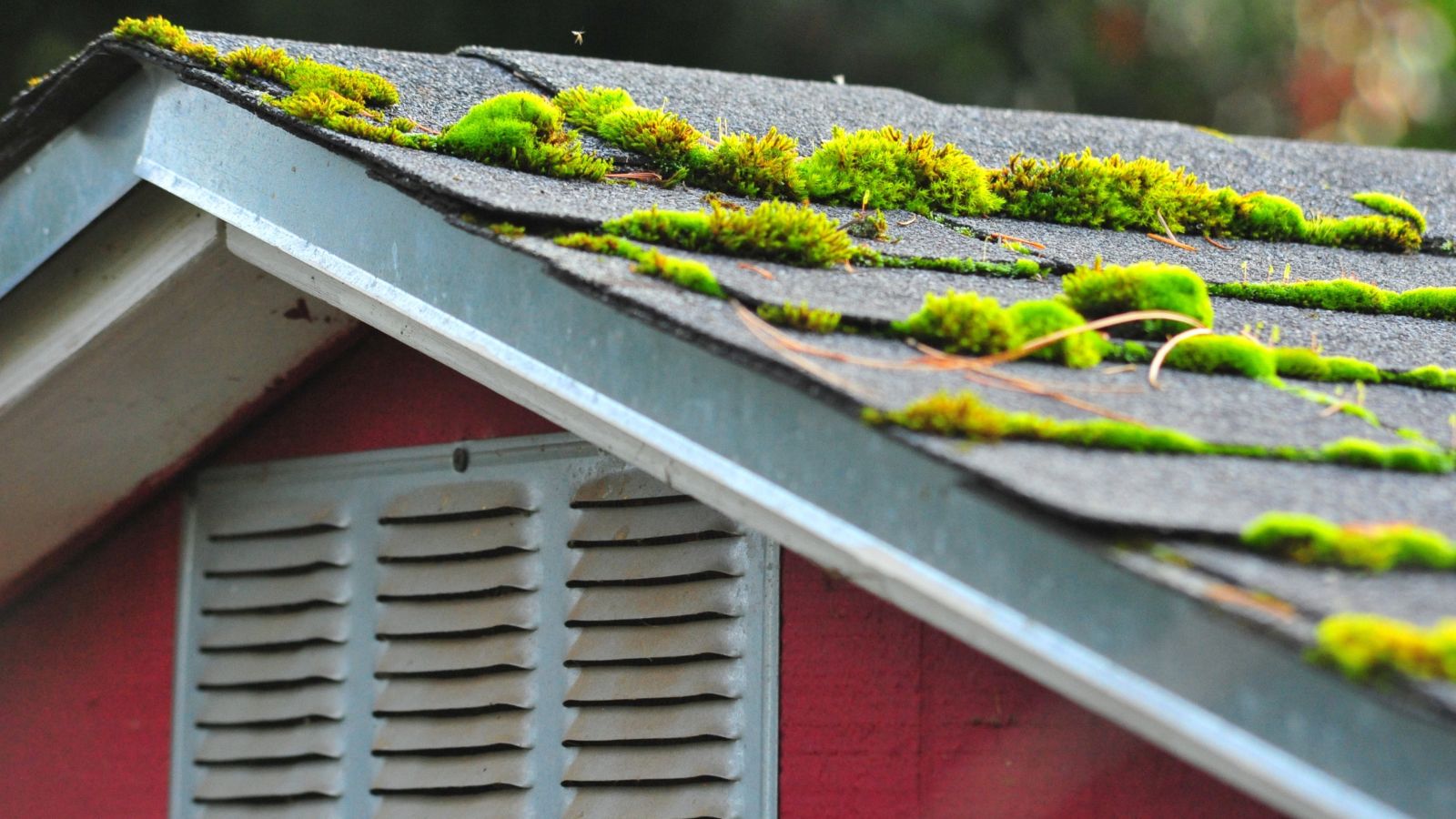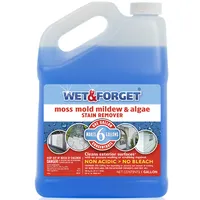How to remove moss on a roof – expert techniques that work and the internet hacks to ignore
It's unsightly and can damage tiles, so how to remove moss on a roof safely? Our experts reveal tried and tested methods


You may have wondered how to kill moss on your roof – or a section of it. Moss tends to grow where a roof isn't exposed to full sun, whether it's north-facing or shaded by trees, and where drainage and maintenance is poor.
More than unsightly, moss can cause damage to tiled roofs in particular, and inevitably clumps of it get pushed by rainfall down into guttering, blocking and damaging drainage further.
Removing moss from a roof isn't complicated, and DIYers can tackle the job a little like they would get rid of moss on a patio. You can also discourage its return fairly easily. However, we must caution that access to any roof, of whatever height, must be safe. Be aware, too, that walking on tiles could break them. Far better to call in professionals than to risk an accident of any kind.
Why does moss grow on a roof?
Prevention is always better than cure, says plant expert John Negus: 'The best thing to do is to find out why the moss is becoming established and change the prevailing conditions.'
'Cool, damp, and shady conditions encourage the growth of algae and moss, so if you live in a humid zone, have a shady garden, or one that's north-facing, you are just as likely to have to get rid of a moss in a lawn as on your roof, patio, or driveway,’ says H&G's Senior Content Editor (Gardens) Holly Crossley.
Another factor that will encourage moss to grow on a roof is poor roof maintenance. If you have allowed debris, perhaps dirt and leaves, to gather between tiles or around guttering, you are offering moss the perfect growing conditions. So, while you may not be able to do much about shade cast by mature trees in a neighboring garden, or to change the orientation of your roof, you can make sure to improve drainage and keep your roof clean so that moss isn't encouraged to grow in the first place.

John has been a garden journalist for over 50 years and regularly answers readers' questions for Homes & Gardens and in Amateur Gardening magazine. He has also written four books and has delivered many talks over the years on horticulture.

Over the years, Holly has been an allotment keeper, a professional gardener, and a botanical illustrator. Having worked for Gardeningetc.com for two years, she now writes about plants and outdoor living for Homes & Gardens. Holly has a particular interest in houseplants (of which she has an ever-growing collection), garden design, and the benefits of gardening for mental health.
How to remove moss on a roof
You will see lots of hacks and suggestions for removing moss from a roof on the internet but we would like to offer another caution: some, such as removing moss with pressure washers, can damage and dislodge roof tiles. Again, far better to employ a professional than to cause expensive damage.
Design expertise in your inbox – from inspiring decorating ideas and beautiful celebrity homes to practical gardening advice and shopping round-ups.
Below, we take you through the best roof moss removal methods, and the kit you need.
Moss removal kit
Scaffolding and a sturdy, fixed ladder are a must for safety. We also recommend:
- Non-slip shoes – The Home Depot has a range of non-slips for DIY
- Safety goggles – these safety goggles are the most highly rated at Amazon
- Gloves – these highly-rated Amazon gloves are waterproof
- A stiff brush – this popular wire brush from Amazon is good for crevices
- Scraper – this decorators' set from Amazon will do the job
- Moss removing solution – our experts recommend Wet & Forget, at Amazon
- Hosepipe
1. Remove roof moss by hand
If you have only just noticed roof moss starting to grow, now is the time to tackle it. Young roof moss can be easily brushed or scraped off with a spatula, or a stiff or wire brush, though you need be careful to not dislodge or damage roof tiles (either with your weight or the brushing action), and you also need to ensure every little bit of moss is dislodged and removed. Leave even small bits of moss root and it will quickly grow back, send out new roots, and disperse more spores.
2. With a hosepipe
If scraping or brushing at young or small patches of moss seems like hard work, you can dislodge it with hose water. You may not even need to use high pressure to do so. Ideally, you should hose from top down so that you don't spray up and under roof tiles.
If you are going to do this, again, you need to remove every trace of the moss, and you want to ensure there is a dry spell after the hosing so that your roof can quickly dry off afterwards. Leave any roots behind in damp weather and your moss will happily grow back.
As with any wet application on a roof, whether water or a moss killing chemical, be sure to work from the guttering up to the apex of the roof so that you don't have to stand on a slippery surface unnecessarily.
Be sure, too, to clean gutters after you have blasted the moss, otherwise they will quickly become blocked, as will downpipes.
3. With a moss roof treatment
If your roof moss problem is a little bigger than a hose or brush can handle, the best option is to use a moss remover. Our Head of Gardens Beth Murton has had success with and recommends Wet & Forget, available at Amazon.
It is simply sprayed on and left, within a few hours killing the moss, which can then be brushed or hosed off easily – or blown down into your yard if the wind gets up beforehand.
For best results, wait for a dry spell, but avoid using moss remover on windy or very hot days – the wind will make application difficult, and both wind and sun will make it dry out before it has had a chance to work its magic on the moss' roots.
As with any chemical treatments, it's vital to protect surrounding plants below your roofline, and pets and people, too.
'Commercial moss killer, like other methods, generally need repeat applications,' John Negus adds. 'Ensure you follow the manufacturer's instructions carefully, as they can differ from product to product.'
'When the moss has blackened and died, rake or brush it off and compost it,' says Homes & Gardens' gardening expert Ruth Hayes.
Wet & Forget, $34.99, Amazon
This patio cleaner removes moss and other green and black stains caused by mold, mildew and algae. Simply apply, and leave to work its magic. Can also be used on your driveway, roof, siding, deck, vinyl, wood, concrete, canvas, aluminum, and upholstery.

Beth has been writing about homes and gardens for over 20 years, contributing to a number of leading magazines, including Real Homes, 4Homes, Period Living and Grand Designs. In 2020, Beth took on the role of launch Editor in Chief of Gardeningetc.com, a website dedicated to gardening and outdoor living. At the start of 2023, she moved to Homes & Gardens as the Head of Gardens, bringing her passion and knowledge for all things outdoors to our team.

Ruth Hayes is the gardening editor of Amateur Gardening magazine. She has a qualification from the Royal Horticultural Society. Her work for Homes & Gardens and Amateur Gardening, the world's oldest weekly gardening publication, involves matching gardening tasks with each season, covering everything from sowing and planting, to pruning, taking cuttings, dealing with pests and diseases and keeping houseplants healthy. She also spends time testing many of the new products that arrive on the gardening market.
How to stop moss growing on a roof
To stop roof moss growing back, first address the causes you can control: trim trees or branches that overhand and shade it, clean gutters and remove any debris between and around tiles. This will allow more light, warmth and air to the roof, which aren't favorable to moss growth.
Next: keep this maintenance up, and this includes thoroughly removing smaller patches of moss as they appear.
If moss persistently appears on your roof, it is worth fixing a zinc, copper or galvanized metal strip along its ridge. As the strip oxidizes, releasing ions that moss does not like. This isn't a quick solution for removing a ton of moss on a roof, but it will discourage regrowth.
Amazon sells a range of roof strips for moss.
FAQs
Can you remove moss from a roof with vinegar?
Cleaning with vinegar is widely acknowledged to be a natural way to get rid of moss from a roof. To do so, mix water and white vinegar in equal parts, spray on to the moss and allow to penetrate to the roots. The moss will die off fairly quickly and can then be scraped or hosed off. Protect plants below.
Can you remove moss on a roof with baking soda?
Baking soda will kill moss but it is not overly practical to apply nor to remove. You are better using a chemical moss killer, vinegar or simply a wire brush.
Can you remove moss on a roof with a power washer?
You can remove moss on a roof with a power washer with care. Power washer hoses are strong enough to damage roofing materials and can even dislodge tiles. You may find that a hose set to medium pressure will do the job just as well, without damage.
Getting rid of moss on a roof isn't a one-time job: it is likely that you will have to tackle it annually, at least on shaded parts of your roof. However, you can slow moss growth and in some cases, stop it completely, with careful maintenance.
As we sign off, we again caution you against climbing onto your roof without putting every safety measure into place – it's always better to call in professionals rather than put yourself at risk.

Lucy Searle has written about interiors, property and gardens since 1990, working her way around the interiors departments of women's magazines before switching to interiors-only titles in the mid-nineties. She was Associate Editor on Ideal Home, and Launch Editor of 4Homes magazine, before moving into digital in 2007, launching Channel 4's flagship website, Channel4.com/4homes. In 2018, Lucy took on the role of Global Editor in Chief for Realhomes.com, taking the site from a small magazine add-on to a global success. She was asked to repeat that success at Homes & Gardens, where she has also taken on the editorship of the magazine.
